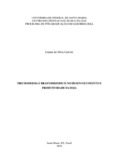| dc.creator | Cadore, Luana da Silva | |
| dc.date.accessioned | 2018-12-17T16:17:11Z | |
| dc.date.available | 2018-12-17T16:17:11Z | |
| dc.date.issued | 2018-05-14 | |
| dc.identifier.uri | http://repositorio.ufsm.br/handle/1/15115 | |
| dc.description.abstract | Soy is a very important crop and for success in cultivation, many factors are critical and help increase productivity. One of these factors is the seed treatment, since it aims to ensure the protection of seeds in the soil. Among the products used for the treatment of seeds are bio-products based on fungi of the genus Trichoderma spp. that act in the promotion of growth of plants and bacteria of the genus Bradyrhizobium japonicum that help in the biological fixation of nitrogen. Thus, the objective of this work was to evaluate the isolated and associated use of bioproducts based on Trichoderma spp. and Bradyrhizobium japonicum on the mitotic index of soybean roots, on soybean development and yield. The treatments used were: Control (absence of trichoderma and Bradyrhizobium japonicum), Ecotrich®, Trichodel®, Bionutri® liquid, Bionutri® peat, Ecotrich® associated with Bionutri® liquid, Ecotrich® associated with Bionutri® peat, Trichodel® associated with Bionutri® and Trichodel® associated with Bionutri® peat.Was evaluated: germination; emergency; length of aerial part; leaf area; root length; fresh and dry matter of shoot and root; surface area, root diameter and volume; first pod insertion; weight of pods; weight of a thousand grains and yield of grains. From the data obtained, it is concluded that the use of commercial bioproducts based on Trichoderma spp. and Bradyrhizobium japonicum in an associated or isolated manner provide better initial development for soybean cultivation as well as increase in final yield of the crop. | eng |
| dc.description.sponsorship | Coordenação de Aperfeiçoamento de Pessoal de Nível Superior - CAPES | por |
| dc.language | por | por |
| dc.publisher | Universidade Federal de Santa Maria | por |
| dc.rights | Attribution-NonCommercial-NoDerivatives 4.0 International | * |
| dc.rights.uri | http://creativecommons.org/licenses/by-nc-nd/4.0/ | * |
| dc.subject | Bioprodutos | por |
| dc.subject | Glycine max | por |
| dc.subject | Promoção de crescimento | por |
| dc.subject | Bioproducts | eng |
| dc.subject | Growth promotion | eng |
| dc.title | Trichoderma e bradyrhizobium no desenvolvimento e produtividade da soja | por |
| dc.title.alternative | Trichoderma and bradyrhizobium in the development and productivity of soybean | eng |
| dc.type | Dissertação | por |
| dc.description.resumo | A soja é uma cultura de grande importância e, para o sucesso no cultivo vários fatores são fundamentais e auxiliam no aumento da produtividade. Um desses fatores é o tratamento de sementes, pois, visa garantir a proteção das sementes no solo. Dentre os produtos utilizados para o tratamento de sementes tem-se bioprodutos à base de fungos do gênero Trichoderma spp. que atuam na promoção de crescimento de plantas e bactérias do gênero Bradyrhizobium japonicum que auxiliam na fixação biológica de nitrogênio. Assim, o objetivo deste trabalho foi avaliar a utilização de forma isolada e associada dos bioprodutos à base de Trichoderma spp. e Bradyrhizobium japonicum sobre o índice mitótico das raízes de soja, no desenvolvimento e na produtividade da soja. Os tratamentos utilizados foram: Controle (ausência de trichoderma e Bradyrhizobium japonicum), Ecotrich®, Trichodel®, Bionutri® líquido, Bionutri® turfa, Ecotrich® associado a Bionutri® líquido, Ecotrich® associado a Bionutri® turfa, Trichodel® associado a Bionutri® líquido e, Trichodel® associado Bionutri® turfa. Avaliou-se a germinação; emergência; comprimento de parte aérea; área foliar; comprimento de raiz; matéria fresca e seca de parte aérea e raiz; área superficial, diâmetro e volume de raiz; inserção de primeira vagem; peso de vagens; peso de mil grãos e rendimento de grãos. Com os dados obtidos, conclui-se que a utilização dos bioprodutos comerciais à base de Trichoderma spp. e Bradyrhizobium japonicum de forma associada ou isolada proporcionam melhor desenvolvimento inicial para a cultura da soja, bem como aumento no rendimento final da cultura. | por |
| dc.contributor.advisor1 | Silva, Antonio Carlos Ferreira da | |
| dc.contributor.advisor1Lattes | http://lattes.cnpq.br/9520096764579199 | por |
| dc.contributor.referee1 | Ethur, Luciana Zago | |
| dc.contributor.referee1Lattes | http://lattes.cnpq.br/3040963753794741 | por |
| dc.contributor.referee2 | Tedesco, Solange Bosio | |
| dc.contributor.referee2Lattes | http://lattes.cnpq.br/2541303074261787 | por |
| dc.creator.Lattes | http://lattes.cnpq.br/5787597161410467 | por |
| dc.publisher.country | Brasil | por |
| dc.publisher.department | Bioquímica | por |
| dc.publisher.initials | UFSM | por |
| dc.publisher.program | Programa de Pós-Graduação em Agrobiologia | por |
| dc.subject.cnpq | CNPQ::CIENCIAS BIOLOGICAS::BIOQUIMICA | por |
| dc.publisher.unidade | Centro de Ciências Naturais e Exatas | por |



